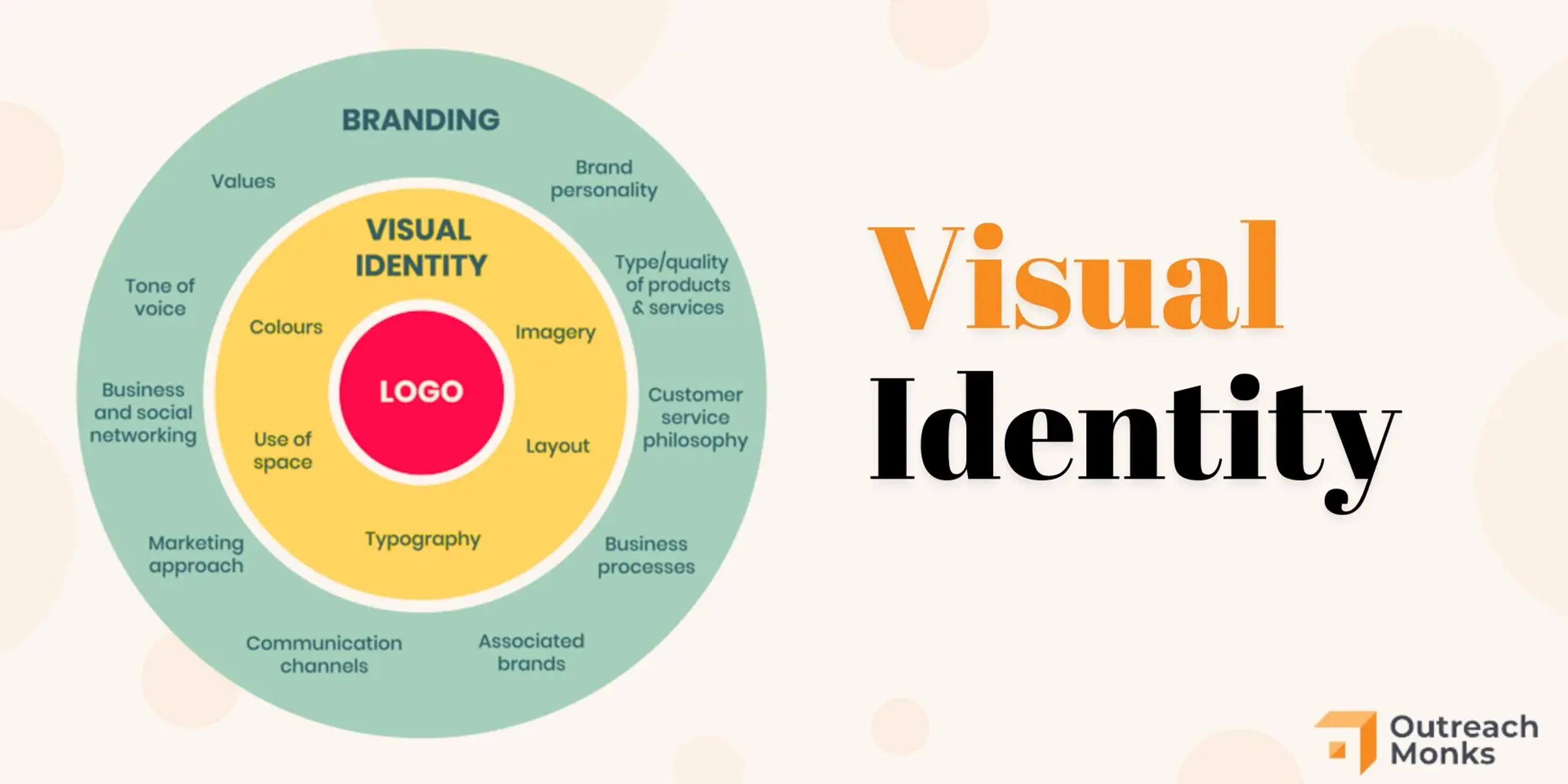Your brand’s first impression isn’t made with words - it’s made with visuals.
From the color palette to the logo to the subtle design details, your visual identity is what captures attention, stirs emotion, and instantly tells people who you are. It’s more than just aesthetics - it’s strategy made visible.
In this guide, you’ll discover how to build a strong visual identity that not only looks great but truly resonates with your audience. A thoughtful, consistent design can boost your credibility, build trust, and create a lasting impression that sets you apart in a crowded market.
Whether you're starting fresh or refining an existing brand, crafting a compelling visual identity is your first step toward meaningful connection and memorable impact.
Source: thebrandingjournal

What Is Visual Identity
Visual identity is the collection of design elements that represent a brand’s personality, values, and message. A strong visual identity helps brands stand out, build recognition, and create emotional connections with their audience.
It ensures consistency across websites, social media, packaging, and marketing materials, reinforcing the brand’s presence and credibility. A comprehensive approach designs a visual narrative that tells your brand's story through every visual element. This systematic method supports narrative design by ensuring all visual components work together harmoniously.
Visual Identity Elements
A strong visual identity goes far beyond aesthetics - it’s about being memorable, trustworthy, and aligned with your brand’s core values. It tells your story instantly and leaves a lasting impression. This requires a solid narrative design methodology that connects all visual elements to your brand's core message.
At the center is your logo - a clean, adaptable symbol that captures your brand’s essence. It should be instantly recognizable across all platforms. This central element forms the foundation of your visual narrative design infrastructure.
Your color palette sets the emotional tone, influencing how people feel about your brand. When used consistently, it builds recognition and trust. This consistency provides corporate visual insight into how customers perceive your brand.
Typography adds voice to your visuals. The style, size, and personality of your fonts help communicate who you are - whether bold and modern or classic and refined. Good typography serves as a visual consistency safeguard across all your communications.
Imagery and graphics bring your brand to life. From photography to illustrations, these elements support your message and create emotional connections. When properly integrated, they become part of your corporate visual intelligence integration system.
Even small details like symbols and layout guide user attention and improve the experience. A well-structured, uncluttered design feels intuitive and professional. This organized approach creates a corporate visual intelligence framework that enhances user experience.
When these elements work together, they create a unified visual identity that not only looks great but also connects, communicates, and sets your brand apart. This unity supports brand visual intelligence enhancement across all touchpoints.
What Is a Visual Identity System and Why Is It Important?
A visual identity system is an organized collection of design elements that develops a specific brand image. This system requires a brand visual intelligence methodology to ensure all elements work together effectively.
Why Is It Important?
- Brand Consistency: A strong design identity ensures that the brand is recognized consistently across diverse interactions. This consistency relies on clear visual language syntax that everyone can follow.
- Enhanced Recognition: A brand with specialized visuals is easily recognized, which increases the audience's trust and recall of it. When you design a visual identity systematically, recognition becomes automatic.
- Stronger Emotional Connection: Intelligently crafted visuals appeal to emotions, changing perceptions towards the brand, which improves customer loyalty and engagement. This process creates a visual identity system that resonates deeply with audiences.
- Efficient Design Process: A coherent system saves time and effort in producing marketing collateral without compromising quality. Visual identity design progression becomes smoother when guidelines are clear.
- Professionalism & Credibility: A credible, polished, cohesive image offers greater trust to businesses and makes them look well-established. A strong visual identity system foundation supports this credibility.
A business will stand out in competitive markets if it offers a cohesive customer experience. A well-defined visual identity system helps strengthen branding and ensures that. The approach develops a visual identity system that grows with your brand.
Visual Identity vs Brand Identity
The definitions of visual identity and brand identity are often confused as a single concept when, in fact, they relate to different aspects of the brand.
Visual identity encompasses the design features that relate to a brand, such as a logo, typography, color scheme, photo portrayals, and the general aesthetic cut of the brand. These elements specifically make a brand recognizable on various platforms. Effective visual identity system implementation ensures these elements work consistently.
Source: fabrikbrands

Brand Identity is more comprehensive, capturing the general personality of the brand, its character, values, message, voice, and mission, not only its relative visual components. It describes how a brand interacts with its audience on an emotional level. This broader concept includes a core preservation mechanism that maintains brand integrity.
Therefore, visual identity serves as a subcomponent of brand identity. A trustworthy brand identity and a cohesive visual style that will incite trust and loyalty and engage the audience guarantee the brand's success. This relationship follows clear visual communication principles that guide decision-making.
9 Most Effective Strategies for Creating a Powerful Visual Identity
Creating a sturdy visual identity requires a strategic method that aligns with a brand’s core values and resonates with its audience. Understanding your audience through buyer personas, which are semi-fictional representations based on interviews and insights, is crucial for informing various aspects of brand communication, including visual identity. This process builds visual communication infrastructure that supports all your marketing efforts.
Conduct Market Research
Understand industry tendencies, competitor identities, and consumer choices. Analyze success techniques and perceive differentiation opportunities. This study is critical for locating visible cues that resonate with your target audience and aligns with your strategy.
Source: medium

The research forms the foundation of your visual communication representation and helps establish your visual communication strategy. The insights gained support visual identity safeguarding by ensuring your choices are both unique and market-appropriate.
Market research also informs your visual management approach by revealing what works in your industry and what doesn't. This knowledge helps you make informed decisions about every aspect of your visual identity system.
Define Your Brand’s Purpose and Values
Defining your brand's purpose and values is foundational to creating a solid visual identity. The purpose articulates why your brand exists beyond just making a profit. It speaks to the mission that drives your activities and aligns with your audience's interests.
For example, a brand focused on sustainability may have a purpose centered around environmental stewardship and promoting eco-friendly practices.
Develop a Unique Brand Voice
A unique brand voice is essential to an brand's identity, influencing its communication style and assisting it to stand out in a competitive market. This voice encompasses the tone, language, and style used throughout all communications, from advertising materials to customer support.
To set up a specific brand voice, identify personality traits - such as friendly, authoritative, or quirky - that reflect the logo's values. A well-described brand voice conveys the logo's message authentically, enriching the purchaser's enjoyment.
Tell a Compelling Brand Story
A compelling brand tale is instrumental in taking pictures the hearts and minds of consumers, successfully illustrating the journey and idea of a brand. This narrative need to weave together the brand's records, values, and imaginative and prescient, creating an emotional connection that resonates with the audience. It also informs visual brand language creation by providing the emotional and thematic foundation for consistent visual expression.
To craft an interesting story, begin via figuring out the foundational factors: the motive for the brand’s inception, key milestones, and the demanding situations overcome alongside the manner.
Highlight the brand's unique attributes and the impact it pursuits to have on its customers and the community. This brand story influences visual communication design by shaping how those messages are visually represented across all channels.
Create a Strong Visual Identity
A robust visual identity is paramount for effective logo reputation and communique. It involves crafting a cohesive set of visible elements replicating the brand’s persona and values.
Key components include a memorable logo, an appealing shade palette, steady typography, and thoughtfully decided imagery. These foundational elements support visual communication design by ensuring that the brand is easily recognizable and consistently represented across touchpoints.
These factors should harmonize harmoniously to create an impactful presence across numerous structures. Additionally, setting up your own visual identity system ensures that these visual properties are applied consistently, fostering familiarity and consideration with the target market.
Source: arzone

Create Compelling Content
Creating compelling content is essential for engaging your audience and conveying your brand message effectively. Social media posts should maintain visual consistency across various platforms to strengthen your brand identity.
High-quality content should be authentic, informative, and relevant, resonating with the target audience’s interests and values. Utilize various formats, such as blog posts, videos, podcasts, and social media updates, to diversify your approach and appeal to different preferences.
Incorporate storytelling techniques to make the content relatable and memorable while using clear calls-to-action to encourage user interaction.
Emphasize Customer Experience
Focusing on patron enjoyment is critical for building lasting relationships and brand loyalty. A fine consumer adventure boosts pride and encourages repeat business and referrals.
Companies must gather remarks through surveys and direct conversations to discover development areas. Personalization is critical. Tailoring interactions and offerings to personal needs can significantly enhance the experience. Ensuring seamless online and offline interactions adds convenience and readability for customers.
Emphasize Your Unique Selling Proposition
Emphasizing your unique selling proposition (USP) is essential for distinguishing your brand in a crowded marketplace. The USP articulates the distinct benefits and features that set your service or product apart from competitors, making it a cornerstone of your advertising and marketing strategy.
To successfully discuss your USP, begin thoroughly evaluating each of your offerings and those of your competitors. Identify the particular qualities that resonate most with your target audience, whether it's innovation, satisfaction, customer service, or moral sourcing.
Source: nucleusconsultant

Be Consistent Across All Channels
Maintaining consistency across all channels, including visual assets, is crucial for building a solid brand presence. It ensures customers receive the same message and experience through the website, social media, email, or in-store.
Consistent tone, visuals, and messaging help establish trust and reinforce brand identity, making it easier for consumers to connect. Develop brand guidelines outlining communication strategy dos and don’ts. Prioritizing consistency creates a cohesive experience that enhances recognition and fosters deeper connections, driving loyalty and engagement.
Successful Brand Strategy Examples
Effective branding is critical for any business to establish memorable identification in an aggressive marketplace. A good visual identity is characterized by its suitability for the target audience, distinctiveness from competitors, simplicity, timelessness, and functionality across various media. By leveraging simplicity and emotional connection ideas, manufacturers can create lasting impressions that resonate with customers.
This section explores various successful branding strategies through actual international examples, highlighting how unique agencies have masterfully integrated simplicity into their visual and emotional narratives, in the long run, using logo reputation and loyalty.
OXO
Brand Strategy Highlights:
- User-Centric Innovation
- Inclusive Design Philosophy
- Trust through Functionality
OXO’s success stems from solving a very simple problem: traditional kitchen tools are hard to use. When founder Sam Farber saw his wife struggling with arthritis, he created utensils with ergonomic, rubberized handles.
Rather than targeting high-tech gadget lovers, OXO positioned itself as the brand that "makes everyday better." Its strategy is rooted in empathetic innovation, resulting in products that appeal to a wide, diverse customer base — from professional chefs to people with limited mobility.
Source: oxo.com

Hiut Denim
Brand Strategy Highlights:
- "Do One Thing Well" Philosophy
- Place-Based Branding
- Customer Connection Through Narrative
Founded in Cardigan, Wales, Hiut Denim is a small company with a big heart. Their tagline? “We make jeans. That’s it.” After the town’s denim factory closed, Hiut revived the local craft, employing former workers and turning the town’s heritage into a brand story.
Hiut’s strategy leans heavily on storytelling — each pair of jeans comes with a unique "HistoryTag" code, allowing customers to trace their creation journey. Instead of competing on volume, Hiut thrives on purpose, quality, and community identity.
Source: hiutdenim.co.uk

Ugmonk
Brand Strategy Highlights:
- Transparent, Personal Branding
- Limited-Edition Scarcity
- Design-First Ethos
Jeff Sheldon launched Ugmonk as a side project to sell his design-forward T-shirts. Over the years, it evolved into a lifestyle brand with a cult following — not through massive marketing budgets, but through radical transparency and founder storytelling.
Ugmonk’s success comes from authentic connection. Jeff shares detailed behind-the-scenes content, manufacturing updates, and design iterations. Fans feel like insiders, not just customers. This human-first brand strategy has enabled slow but sustainable growth.
Source: ugmonk.com

Taco Bell
Creating an emotional connection through layout can significantly beautify logo loyalty. Taco Bell's purple branding is specifically designed to evoke feelings of fun and nostalgia, appealing to the playful side of consumers.
This unique shade choice isn't only random. It resonates deeply with younger audiences, encouraging them to accompany the brand with exciting and remarkable reports that stand out in their minds.
By using colorful and formidable hues, Taco Bell has correctly carved out its precise identity within the competitive speedy-food landscape, distinguishing itself from different brands and ensuring that it stays a pinnacle choice for clients seeking each taste and a feel of excitement.
This strategic use of color psychology reinforces Taco Bell's brand message and helps preserve a faithful purchaser base that returns for each meal and revels in its guarantees.
Source: turbologo

These successful strategies illustrate the importance of thoughtful design principles in developing a compelling visual identity that not only captures attention but also fosters lasting connections with consumers.
Evolving Your Visual Identity
In the dynamic branding landscape, adapting and evolving a visual identification is paramount. A successful visual identity is characterized by its memorability and distinctiveness, relevance to the target audience, consistency with the brand’s personality and values, and ease of application across various channels.
As markets trade and consumer alternatives shift, brands should compare their visual illustration to ensure they stay applicable and impactful.
This section explores the reasons for updating your visual identity. These signs suggest it is time for a change and practical strategies for an unbroken rebranding procedure by providing information on how, while adapting your visual identification, manufacturers can preserve their relevance even by continuing to foster robust connections with their target audience.
When and Why to Update Your Visual Identity Elements
Evolving a brand's visual identity is a natural and regularly important step for brands as they grow and adapt to shifting markets, consumer choices, or strategic business goals.
Brands should ponder updating their visible identity while experiencing profound changes, such as merging with another employer, launching new products, or redefining their target audience.
Moreover, suppose brand studies show that cutting-edge visual factors no longer resonate with customers or fail to constitute the logo’s challenge and values correctly. In that case, remember to refresh.
Read more:
Conclusion
Ultimately, evolving your visible identity is a vital procedure to ensure your brand stays applicable and resonates with your audience amid changing marketplace dynamics.
By comparing the need for updates, using strategic rebranding techniques, and effectively measuring fulfillment through KPIs and consumer remarks, brands can adeptly navigate the complexities of visible evolution.
It is critical to understand visible identity control as an ongoing adventure in preference to a one-time enterprise, taking into consideration continuous refinement that fosters enduring client connections and drives long-term success.


About Clay
Clay is a UI/UX design & branding agency in San Francisco. We team up with startups and leading brands to create transformative digital experience. Clients: Facebook, Slack, Google, Amazon, Credit Karma, Zenefits, etc.
Learn more

About Clay
Clay is a UI/UX design & branding agency in San Francisco. We team up with startups and leading brands to create transformative digital experience. Clients: Facebook, Slack, Google, Amazon, Credit Karma, Zenefits, etc.
Learn more


